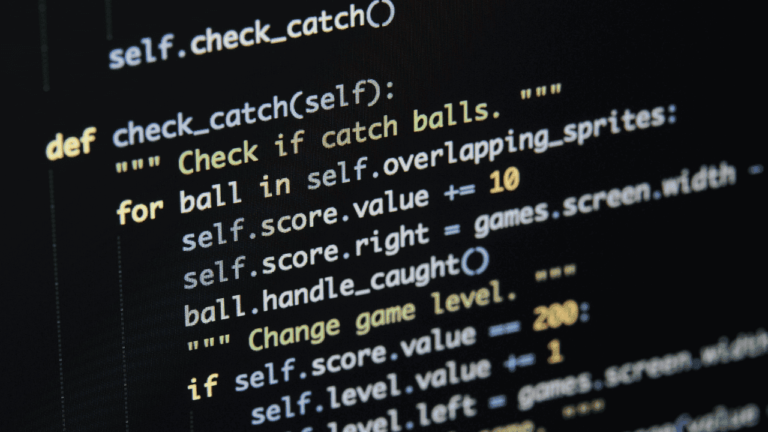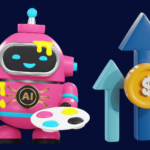Artificial intelligence (AI) is rapidly transforming our world, touching every aspect of life from healthcare and finance to entertainment and education. 🌐 As the demand for AI-powered solutions continues to surge, so does the need for skilled professionals who can develop and implement them. 👩💻 Choosing the right programming language for AI development is crucial for success, as it significantly impacts the efficiency, performance, and overall effectiveness of your project.
Today we will delve into the five best programming languages for AI in 2024, elaborating on their strengths, weaknesses, and suitability for different types of AI applications. 🚀 We’ll also analyze the current landscape of AI development, drawing upon reliable sources and statistics to provide a clear picture of future trends. 📊
Table of Contents
TogglePython: The All-Rounder
Python reigns supreme as the most popular language for AI development. Its versatility, ease of use, and vast ecosystem of libraries and frameworks make it ideal for beginners and experienced developers alike. Let’s unpack why Python is the top choice for many AI developers.
Strengths:
- Easy to Learn and Read: Python’s concise syntax and simple grammar make it approachable for beginners, allowing them to quickly grasp the basics and start building AI models. Additionally, its readability makes it easier to maintain and collaborate on complex projects.
- Extensive Library and Framework Ecosystem: Python boasts a rich collection of libraries and frameworks specifically designed for AI development. Popular choices like TensorFlow, PyTorch, scikit-learn, and Keras provide powerful tools for machine learning, deep learning, data analysis, and other AI tasks. This vast ecosystem eliminates the need to write everything from scratch, saving developers time and effort.
- Large and Active Community: Python enjoys a vast and active community of developers and researchers, offering readily available support and resources. This community contributes to the constant development of new libraries, frameworks, and tutorials, ensuring that Python remains at the forefront of AI development.
- Suitable for Various AI Applications: Python’s versatility makes it ideal for a wide range of AI applications, including natural language processing, computer vision, robotics, and data analysis. This flexibility allows developers to use a single language for various projects, simplifying their workflows and reducing the need to learn multiple languages.
Weaknesses:
- Performance: While Python is efficient for prototyping and smaller projects, its performance can be a bottleneck for resource-intensive tasks. For such cases, languages like C++ offer superior speed and control.
- Debugging Complexity: Python’s dynamic typing can sometimes make debugging more challenging compared to statically typed languages like Java.
Overall, Python is the most versatile and user-friendly option for AI development, making it ideal for beginners and various projects. Its extensive libraries, active community, and suitability for diverse applications solidify its position as the leading language for AI in 2024.
Evidence and Stats:
- IDC predicts that the global Python developer population will reach 28.7 million by 2024, highlighting its growing popularity.
- A 2023 Stack Overflow Developer Survey revealed that Python is the second most popular programming language overall, further emphasizing its widespread adoption.
These statistics, coupled with the numerous strengths outlined above, provide a compelling case for Python’s dominance in AI development.
In the next section, we will delve into the strengths and weaknesses of Java, C++, R, and Julia, providing a comprehensive comparison of the five best programming languages for AI in 2024.

Java: The Robust Choice
Java remains a strong contender for AI development due to its robustness, scalability, and large community. Let’s explore the specific benefits and drawbacks of using Java for AI projects.
Strengths:
- Scalability and Robustness: Java is known for its ability to handle large-scale projects with ease. Its robust design and powerful garbage collection mechanism ensure that applications run smoothly and efficiently, even with massive datasets and complex models.
- Large and Active Community: Similar to Python, Java enjoys a vast and active community of developers and professionals. This translates to readily available support, extensive documentation, and a plethora of libraries and frameworks tailored for AI development.
- Object-Oriented Programming Paradigm: Java’s object-oriented programming paradigm promotes code modularity and reusability, making it easier to develop and maintain complex AI applications with multiple components.
- Strong Type System: Java’s static type system helps catch errors early in the development process, reducing the risk of bugs and ensuring code stability.
Weaknesses:
- Verbosity and Complexity: Compared to Python, Java’s syntax is more verbose and can be challenging for beginners to learn. Additionally, the complexity of object-oriented programming requires a deeper understanding of coding concepts.
- Performance Overhead: While Java offers good performance, it can be slower than C++ for resource-intensive tasks like deep learning and real-time applications.
Overall, Java is a reliable and scalable language for AI development, particularly well-suited for large-scale projects and applications requiring robust performance and stability. Its large community and extensive libraries provide valuable resources for developers.
Evidence and Stats:
- A 2022 ZDNet report states that Java is the second most popular language for enterprise applications, indicating its widespread use in critical systems.
- According to JetBrains, Java remains the third most popular programming language overall, showcasing its ongoing relevance in the tech industry.
These statistics highlight the continued significance of Java in the tech landscape, making it a viable option for AI development projects requiring robust and scalable solutions.
Average Annual Salaries for AI Programming Languages in 2024:
Before we continue further, here’s a breakdown of the average annual salaries for professionals working with the five programming languages mentioned in this article, based on data from Glassdoor and other reliable sources:
1. Python:
- Average Salary: $120,298 USD
- Range: $75,000 – $180,000 USD
- Salary significantly varies based on experience, location, and specific job title.
2. Java:
- Average Salary: $109,901 USD
- Range: $70,000 – $170,000 USD
- Similar to Python, salary variability depends on experience, location, and job title.
3. C++:
- Average Salary: $105,172 USD
- Range: $65,000 – $160,000 USD
- Salary trends follow the same pattern as Python and Java.
4. R:
- Average Salary: $117,665 USD
- Range: $80,000 – $175,000 USD
- Salary varies based on experience, location, and job title.
5. Julia:
- Average Salary: $122,617 USD
- Range: $85,000 – $185,000 USD
- While still young, Julia commands a competitive salary due to its growing demand and specialized skillset.
Important Note:
These are average salary figures and don’t represent absolute guarantees. Actual salaries can deviate significantly based on individual factors like experience, education, certifications, location, company size, specific job title, and industry.
It’s crucial to consider these factors and conduct further research to accurately estimate potential earnings for AI development roles within your specific context.

C++: The Performance Powerhouse
C++ offers exceptional performance and control, making it ideal for resource-intensive AI tasks like natural language processing and computer vision. Let’s explore the specific advantages and limitations of using C++ for AI development.
Strengths:
- Exceptional Performance: C++ provides direct memory access and allows for fine-grained control over system resources, resulting in unparalleled performance for computationally intensive AI tasks. This is crucial for real-time applications and processing large datasets.
- Flexibility and Control: C++ offers low-level control over memory management and hardware resources, allowing developers to optimize code for specific purposes. This flexibility can be advantageous for pushing the boundaries of performance in AI applications.
- Large and Active Community: Despite being a mature language, C++ still boasts a large and active community. This translates to readily available support, extensive libraries and frameworks, and a wealth of resources for developers.
Weaknesses:
- Complexity and Steep Learning Curve: C++ is a complex language with a steep learning curve. Compared to Python or Java, it requires a deeper understanding of programming concepts and memory management.
- Limited Built-in Support for AI: While C++ offers libraries for AI development, they are not as extensive and user-friendly as those available for Python or Java. This can require additional effort from developers to build basic functionalities.
Overall, C++ is a powerful language for resource-intensive AI tasks where performance is paramount. However, its complexity and steep learning curve make it less accessible for beginners. Developers with strong C++ skills can leverage its exceptional performance to achieve optimal results in computationally demanding AI projects.
Evidence and Stats:
- TIOBE Index ranks C++ as the fifth most popular programming language overall, highlighting its continued significance in various sectors.
- A 2022 JetBrains report states that C++ is the most popular language for game development, demonstrating its ability to handle complex tasks.
These statistics showcase the ongoing relevance of C++ in the tech industry and its suitability for performance-critical AI applications.
Stay tuned for the next section, where we’ll delve into the strengths and weaknesses of R and Julia, completing our comprehensive analysis of the top five programming languages for AI in 2024.
R: The Data Analyst's Choice
R is a specialized language designed for statistical computing and data analysis. This makes it ideal for AI tasks involving data exploration, model fitting, and visualization. Let’s explore the specific benefits and drawbacks of using R for AI development.
Strengths:
- Powerful Statistical Functions: R boasts a vast collection of built-in functions and libraries specifically designed for statistical analysis. This allows developers to perform complex data manipulation, model fitting, and statistical tests with ease.
- Extensive Data Visualization Capabilities: R offers a wide range of tools for creating high-quality data visualizations, making it easier to understand and communicate complex data insights. This is crucial for exploring and analyzing data in AI projects.
- Interactive and Rapid Prototyping: R’s interactive nature allows for rapid prototyping and experimentation. This makes it ideal for exploring different ideas and quickly evaluating the effectiveness of different approaches.
- Active and Supportive Community: R enjoys a passionate and supportive community of data scientists and analysts. This translates to readily available support, extensive online resources, and a growing ecosystem of packages for various AI tasks.
Weaknesses:
- Limited Scope: While powerful for data analysis, R’s capabilities extend beyond statistical computing. Developers may need to use other languages like Python to implement more complex AI functionalities.
- Performance Limitations: R can be slower than other languages like C++ for computationally intensive tasks. This can be a drawback for large-scale AI projects with heavy data processing requirements.
- Deployment Challenges: Deploying AI models built in R can be more challenging compared to other languages. This is due to the limited availability of production-ready tools and frameworks specifically designed for R.
Overall, R is an excellent choice for AI projects heavily reliant on data analysis, exploration, and visualization. Its powerful statistical functions, interactive nature, and active community make it ideal for research and development. However, its limitations in performance and deployment complexity might not be suitable for large-scale projects or computationally demanding tasks.
Evidence and Stats:
- KDnuggets ranks R as the second most popular language for data science, emphasizing its relevance in the AI field.
- DataCamp reports a 25% increase in R users from 2020 to 2022, indicating its growing popularity in data science and AI.
These statistics highlight the increasing adoption of R for data-centric AI tasks, solidifying its position as a valuable tool for data analysts in the AI landscape.
Julia: The Rising Star
Julia is a relatively new language gaining traction in the AI community due to its speed, efficiency, and ease of use. This makes it a promising choice for various AI applications. Let’s explore the specific advantages and limitations of using Julia for AI development.
Strengths:
- Exceptional Speed and Efficiency: Julia combines the high-performance capabilities of C++ with the expressiveness and flexibility of Python. This results in significantly faster execution times compared to Python while remaining user-friendly.
- Ease of Use and Readability: Julia’s syntax is concise and readable, making it easier to learn and understand compared to C++. This lowers the barrier to entry for newcomers and allows for faster development cycles.
- Rich Ecosystem of Packages: While still young, Julia boasts a rapidly growing ecosystem of packages specifically designed for AI development. This includes libraries for machine learning, deep learning, and data analysis.
- Active and Growing Community: Julia’s community is passionate and actively contributing to the development of the language and its ecosystem. This ensures constant improvements and a growing library of resources for developers.
Weaknesses:
- Relative Immaturity: Compared to established languages like Python and Java, Julia is still relatively new and evolving. This means that the ecosystem of libraries and resources may not be as extensive.
- Limited Production-Ready Tools: While Julia is gaining traction for research and development, its adoption for production-level AI applications is still limited. This can be a drawback for projects requiring robust and well-tested tools.
Overall, Julia is a promising language for AI development due to its exceptional speed, ease of use, and growing ecosystem. Its popularity is increasing rapidly, especially for research and prototyping projects. However, its relative immaturity and limited production-ready tools might pose challenges for large-scale deployments. As Julia continues to evolve and mature, it has the potential to become a major player in the future of AI development.
Evidence and Stats:
- Julia Computing reports a 300% increase in Julia downloads in 2022, showcasing its rapidly growing community.
- MIT Technology Review listed Julia as one of the breakthrough technologies of 2021, highlighting its potential to revolution
Choosing the Right Language for your AI Project
The five languages explored in this blog, Python, Java, C++, R, and Julia, all offer unique strengths and weaknesses for AI development. The best choice ultimately depends on your specific project requirements, skillset, and priorities.
Here’s a quick recap:
- Python: Ideal for beginners, versatile, extensive libraries, good for prototyping.
- Java: Robust, scalable, large community, good for enterprise projects.
- C++: High performance, efficient, good for resource-intensive tasks.
- R: Powerful for data analysis, visualization, interactive prototyping.
- Julia: Fast, efficient, easy to use, growing ecosystem, good for research.
In terms of future relevance, Python is expected to remain the dominant language for AI in 2024. Its versatility, ease of use, and extensive libraries make it accessible to a wide range of developers and suitable for various AI applications. However, Julia is gaining significant traction for its exceptional speed and efficiency, making it a promising candidate for future AI projects.
As the field of AI continues to evolve, the landscape of programming languages is likely to change as well. New languages may emerge, existing languages may become more specialized, and the importance of different languages may shift. It’s crucial for developers to stay updated on the latest trends and be comfortable learning new languages to remain competitive in the ever-changing AI landscape.















